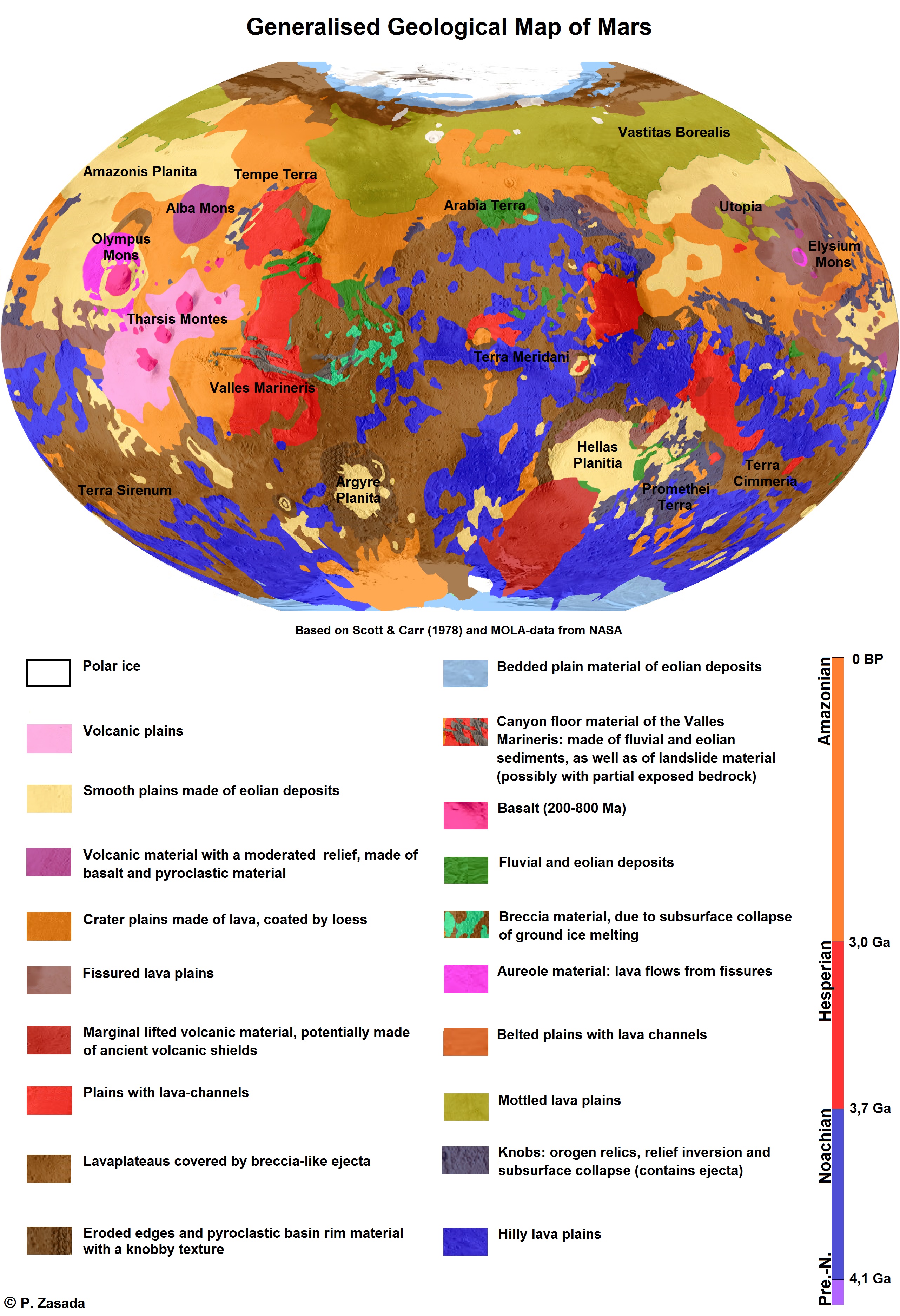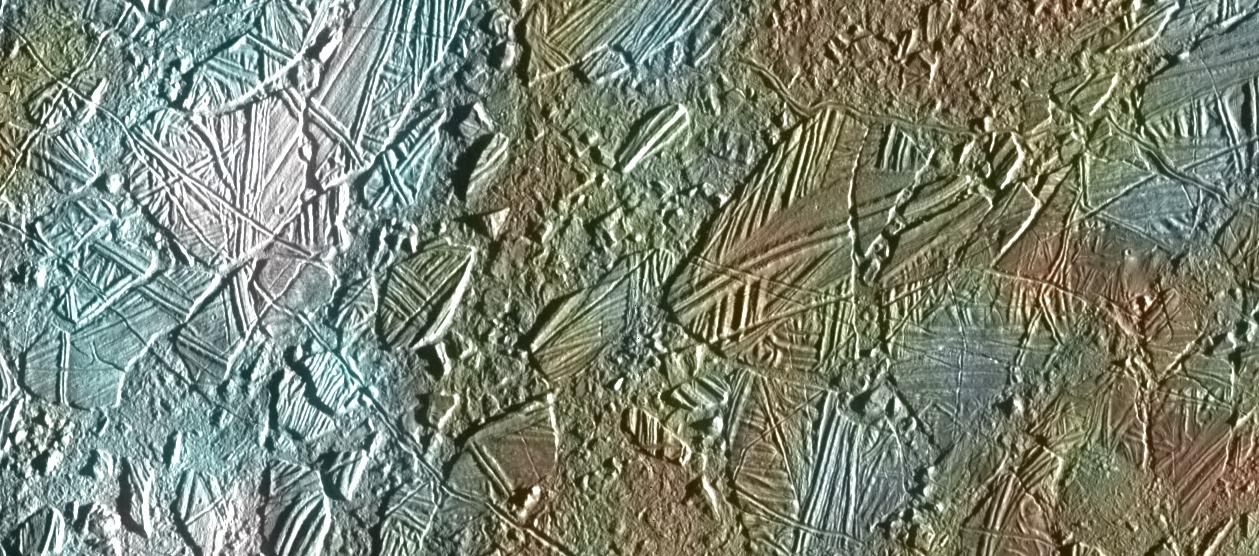|
Iani Chaos
Iani Chaos is a region of chaos terrain at the south end of the outflow channel Ares Vallis, of the Margaritifer Sinus quadrangle (MC-19) region of the planet Mars, centered at approximately ~342°E, 2°S. This is the source region of Ares Vallis. The chaotic terrain is widely believed to have formed via the removal of subsurface water or ice, resulting in flooding at the surface, and the formation of Ares Vallis. Within Iani Chaos, deposited stratigraphically above the chaotic terrain, are smooth, low-slope, intermediate-to-light-toned deposits that are rich in a hydrated mineral that is most likely gypsum as well as hematite. Mapbeer.jpg, Map showing location of Arsinoes Chaos (far left), Iani Chaos, Aureum Chaos, Margaritifer Chaos, and other nearby features Mars Science Laboratory Several sites in the Margaritifer Sinus quadrangle have been proposed as areas to send NASA's next major Mars rover, the Mars Science Lab. Among the top 33 landing sites was Iani Chaos. A picture ... [...More Info...] [...Related Items...] OR: [Wikipedia] [Google] [Baidu] |
Margaritifer Sinus Quadrangle
The Margaritifer Sinus quadrangle is one of a series of 30 quadrangle maps of Mars used by the United States Geological Survey (USGS) Astrogeology Research Program. The Margaritifer Sinus quadrangle is also referred to as MC-19 (Mars Chart-19). The Margaritifer Sinus quadrangle covers the area from 0° to 45° west longitude and 0° to 30° south latitude on Mars. Margaritifer Sinus quadrangle contains Margaritifer Terra and parts of Xanthe Terra, Noachis Terra, Arabia Terra, and Meridiani Planum. The name of this quadrangle means "pearl bay" after the pearl coast at Cape Comorin in South India. This quadrangle shows many signs of past water with evidence of lakes, deltas, ancient rivers, inverted channels, and chaos regions that released water. Margaritifer Sinus contains some of the longest lake-chain systems on Mars, perhaps because of a wetter climate, more groundwater, or some of each factor. The Samara/Himera lake-chain system is about 1800 km long; the Parar ... [...More Info...] [...Related Items...] OR: [Wikipedia] [Google] [Baidu] |
Aram Chaos
Aram Chaos, centered at 2.6°N, 21.5°W, is a heavily eroded impact crater on Mars. It lies at the eastern end of the large canyon Valles Marineris and close to Ares Vallis. Various geological processes have reduced it to a circular area of chaotic terrain. Aram Chaos takes its name from Aram, one of the classical albedo features observed by Giovanni Schiaparelli, who named it after the Biblical land of Aram. Spectroscopic observation from orbit indicates the presence of the mineral hematite, likely a signature of a once aqueous environment. Description Aram Chaos is an impact crater on Mars measuring 280 kilometers (170 mi) in diameter. It lies in the Oxia Palus quadrangle in a region called Margaritifer Terra, and its exact coordinates on Mars are . The Thermal Emission Imaging System (THEMIS) on the orbiter ''Mars Odyssey'' found gray crystalline hematite on the floor of Aram Chaos and CRISM, the spectroscope on the MRO, found hydrated sulfates, jarosite, and hematite. The ... [...More Info...] [...Related Items...] OR: [Wikipedia] [Google] [Baidu] |
Arsinoes Chaos
Arsinoes Chaos is a chaos terrain in the Margaritifer Sinus quadrangle on Mars. It is 200 km in diameter. Its location is 7.66 °S and 27.9 °W. Arsinoes Chaos was named after Arsinoe, a queen of ancient Egypt, daughter of Ptolemy and Berenice. Chaos terrain on Mars is distinctive; nothing on Earth compares to it. Chaos terrain generally consists of irregular groups of large blocks, some tens of kilometres across and a hundred or more meters high. The tilted and flat topped blocks form depressions hundreds of metres deep. A chaotic region can be recognized by a rat's nest of mesas, buttes, and hills, chopped through with valleys which in places look almost patterned. Some parts of this chaotic area have not collapsed completely—they are still formed into large mesas, so they may still contain water ice. Some buttes and mesas in Arsinoes display layering. Many places on Mars show rocks arranged in layers. Rock can form layers in a variety of ways. Volcanoes, wind, or wat ... [...More Info...] [...Related Items...] OR: [Wikipedia] [Google] [Baidu] |
List Of Areas Of Chaos Terrain On Mars
This is a list of areas of chaos terrain officially named by the International Astronomical Union on the planet Mars. Chaos terrain (or chaotic terrain) is an astrogeological term used to denote planetary surface areas where features such as ridges, cracks, and plains appear jumbled and enmeshed with one another. Coordinates are in planetocentric latitude with east longitude. Areas of chaos terrain are usually named after a nearby albedo feature as in line with the IAU's rules on planetary nomenclature. Such an albedo feature must feature on the maps of Mars made by either Giovanni Schiaparelli or Eugène Michel Antoniadi and are listed at Classical albedo features on Mars. References This list was adapted from the public domaiGazetteer of Planetary Nomenclature courtesy of the United States Geological Survey The United States Geological Survey (USGS), formerly simply known as the Geological Survey, is a scientific agency of the United States government. The scienti ... [...More Info...] [...Related Items...] OR: [Wikipedia] [Google] [Baidu] |
Geology Of Mars
The geology of Mars is the scientific study of the surface, crust, and interior of the planet Mars. It emphasizes the composition, structure, history, and physical processes that shape the planet. It is analogous to the field of terrestrial geology. In planetary science, the term ''geology'' is used in its broadest sense to mean the study of the solid parts of planets and moons. The term incorporates aspects of geophysics, geochemistry, mineralogy, geodesy, and cartography. A neologism, areology, from the Greek word ''Arēs'' (Mars), sometimes appears as a synonym for Mars's geology in the popular media and works of science fiction (e.g. Kim Stanley Robinson, Kim Stanley Robinson's Mars trilogy). The term areology is also used by the Areological Society. Geological map of Mars (2014) File:Geologic Map of Mars figure2.pdf, Figure 2 for the geologic map of Mars Global Martian topography and large-scale features Composition of Mars Mars is a terrestrial planet, whic ... [...More Info...] [...Related Items...] OR: [Wikipedia] [Google] [Baidu] |
Chaos Terrain
In astrogeology, chaos terrain, or chaotic terrain, is a planetary surface area where features such as ridges, cracks, and plains appear jumbled and enmeshed with one another. Chaos terrain is a notable feature of the planets Mars and Mercury, Jupiter's moon Europa, and the dwarf planet Pluto. In scientific nomenclature, "chaos" is used as a component of proper nouns (e.g., "Aureum Chaos" on Mars). On Mars Wikichaosmap.jpg, Tography map of Oxia Palus region of Mars showing the location of a number of chaos regions Mapbeer.jpg, Map showing location of Arsinoes Chaos (far left), Iani Chaos, Aureum Chaos, Margaritifer Chaos, and other nearby features Image:Margaritifer Sinus Map.JPG, Map of Margaritifer Sinus quadrangle with major features labeled. Aureum Chaos is near the top of the map. Image:Canyons and Mesas of Aureum Chaos in Oxia Palus.JPG, Huge canyons in Aureum Chaos, as seen by THEMIS. Gullies are rare at this latitude. Image from Margaritifer Sinus quadrangle. Im ... [...More Info...] [...Related Items...] OR: [Wikipedia] [Google] [Baidu] |
THEMIS
In Greek mythology and Ancient Greek religion, religion, Themis (; grc, Θέμις, Themis, justice, law, custom) is one of the twelve Titans, Titan children of Gaia and Uranus (mythology), Uranus, and the second wife of Zeus. She is the goddess and personification of justice, divine order, fairness, law, and custom, and her symbols include the Scales of Justice (symbol), Scales of Justice. She is also associated with oracles and prophecies, including the Pythia, Oracle of Delphi. Name ''Themis'' means "divine law" rather than human ordinance, literally "that which is put in place", from the Greek verb ''títhēmi'' (wikt:τίθημι, τίθημι), meaning "to put." To the ancient Greeks she was originally the organizer of the "communal affairs of humans, particularly assemblies." Moses Finley remarked of ''themis'', as the word was used by Homer in the 8th century BCE, to evoke the social order of the 10th- and 9th-century Greek Dark Ages: Finley adds, "There was ''them ... [...More Info...] [...Related Items...] OR: [Wikipedia] [Google] [Baidu] |
Mars Science Lab
Mars Science Laboratory (MSL) is a robotic space probe mission to Mars launched by NASA on November 26, 2011, which successfully landed ''Curiosity'', a Mars rover, in Gale Crater on August 6, 2012. The overall objectives include investigating Mars' habitability, studying its climate and geology, and collecting data for a human mission to Mars. The rover carries a variety of scientific instruments designed by an international team. Overview MSL successfully carried out the most accurate Martian landing of any known spacecraft at the time, hitting a small target landing ellipse of only , in the Aeolis Palus region of Gale Crater. In the event, MSL achieved a landing east and north of the center of the target. This location is near the mountain Aeolis Mons (a.k.a. "Mount Sharp"). The rover mission is set to explore for at least 687 Earth days (1 Martian year) over a range of . The Mars Science Laboratory mission is part of NASA's Mars Exploration Program, a long-term effor ... [...More Info...] [...Related Items...] OR: [Wikipedia] [Google] [Baidu] |
Aureum Chaos
Aureum Chaos is a rough, collapsed region ( chaos terrain) in the Margaritifer Sinus quadrangle (MC-19) portion of the planet Mars at approximately 4.4° south latitude and 27° west longitude, it is also in the west of Margaritifer Terra. It is 368 km across and was named after a classical albedo feature name. The classic name came from one of the first maps of Mars drawn by Schiaparelli who has been called the "Father of Mars." He called a feature "Aurea Cherso, which translates to the golden peninsula—an ancient name for Malaya. Aureum is the Latin word for gold. In chemistry, the symbol for gold is Au from gold's Latin name. In many places, the canyons of Aureum Chaos are about 1 km deep—a little more than half the depth of the Grand Canyon. But, Aureum Chaos covers an area about the size of the state of Alabama, almost 20 times larger than the Grand Canyon National Park. Description Aureum Chaos is a major canyon system and collapsed area. Large outfl ... [...More Info...] [...Related Items...] OR: [Wikipedia] [Google] [Baidu] |
NASA
The National Aeronautics and Space Administration (NASA ) is an independent agency of the US federal government responsible for the civil space program, aeronautics research, and space research. NASA was established in 1958, succeeding the National Advisory Committee for Aeronautics (NACA), to give the U.S. space development effort a distinctly civilian orientation, emphasizing peaceful applications in space science. NASA has since led most American space exploration, including Project Mercury, Project Gemini, the 1968-1972 Apollo Moon landing missions, the Skylab space station, and the Space Shuttle. NASA supports the International Space Station and oversees the development of the Orion spacecraft and the Space Launch System for the crewed lunar Artemis program, Commercial Crew spacecraft, and the planned Lunar Gateway space station. The agency is also responsible for the Launch Services Program, which provides oversight of launch operations and countdown management f ... [...More Info...] [...Related Items...] OR: [Wikipedia] [Google] [Baidu] |
Martian Chaos Terrain
Chaos terrain on Mars is distinctive; nothing on Earth compares to it. Chaos terrain generally consists of irregular groups of large blocks, some tens of kilometers across and a hundred or more meters high. The tilted and flat topped blocks form depressions hundreds of metres deep. A chaotic region can be recognized by a rat's nest of mesas, buttes, and hills, chopped through with valleys which in places look almost patterned. Some parts of this chaotic area have not collapsed completely—they are still formed into large mesas, so they may still contain water ice. Chaos regions formed long ago. By counting craters (more craters in any given area means an older surface) and by studying the valleys' relations with other geological features, scientists have concluded the channels formed 2.0 to 3.8 billion years ago. Locations The greatest concentrations of chaotic terrain are in the same locations as giant, ancient river valleys. Because so many large channels seem to originate ... [...More Info...] [...Related Items...] OR: [Wikipedia] [Google] [Baidu] |
Hematite
Hematite (), also spelled as haematite, is a common iron oxide compound with the formula, Fe2O3 and is widely found in rocks and soils. Hematite crystals belong to the rhombohedral lattice system which is designated the alpha polymorph of . It has the same crystal structure as corundum () and ilmenite (). With this it forms a complete solid solution at temperatures above . Hematite naturally occurs in black to steel or silver-gray, brown to reddish-brown, or red colors. It is mined as an important ore mineral of iron. It is electrically conductive. Hematite varieties include ''kidney ore'', ''martite'' (pseudomorphs after magnetite), ''iron rose'' and ''specularite'' (specular hematite). While these forms vary, they all have a rust-red streak. Hematite is not only harder than pure iron, but also much more brittle. Maghemite is a polymorph of hematite (γ-) with the same chemical formula, but with a spinel structure like magnetite. Large deposits of hematite are found in ... [...More Info...] [...Related Items...] OR: [Wikipedia] [Google] [Baidu] |





